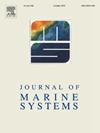Spring phytoplankton distributions and primary productivity in waters off northern Norway
Abstract
The distributions of phytoplankton, zooplankton and hydrographic features off the coast of northern Norway were assessed in late April – early May 2019 using ship-based observations (CTD casts and Moving Vessel Profilers) and autonomous vehicles. A satellite chlorophyll climatology was generated to place our in-situ observations within a longer temporal sequence. Substantial spatial and temporal variability on all scales was observed in both the observations and climatology. Spring phytoplankton accumulation usually is initiated in the south on the continental shelf, and advanced in a northerly direction through time. Accumulations in the surface layer of deeper waters off the continental shelf occurred 2–3 weeks later than those on the shelf. During our survey, primary productivity was greatest in offshore waters where nutrients were not depleted and exceeded 2 g C m−2 d−1. The greatest Calanus finmarchicus abundances were associated with low chlorophyll concentrations, suggesting a major impact of grazing on phytoplankton biomass, but estimates of phytoplankton growth and zooplankton removal suggested that Calanus was responsible for a variable fraction (3–69%) of the daily chlorophyll changes. Vertical changes in chlorophyll were related to physical features during some transects, but to grazing and sinking in others. Understanding the spatial and temporal variations of the coupling of phytoplankton to zooplankton is essential to effective management of this important commercial species in Norwegian waters.

 求助内容:
求助内容: 应助结果提醒方式:
应助结果提醒方式:


